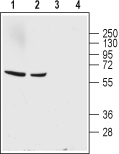Overview
- Peptide (C)ERNMHQMTDGLDK, corresponding to amino acids residues 194-206 of rat GAT-1 (Accession P23978). 2nd extracellular loop.
- Rat and mouse brain lysates (1:200).
 Western blot analysis of rat (lanes 1 and 3) and mouse (lanes 2 and 4) brain lysates:1,2. Anti-GABA Transporter 1 (GAT-1) (extracellular) Antibody (#AGT-001), (1:200).
Western blot analysis of rat (lanes 1 and 3) and mouse (lanes 2 and 4) brain lysates:1,2. Anti-GABA Transporter 1 (GAT-1) (extracellular) Antibody (#AGT-001), (1:200).
3,4. Anti-GABA Transporter 1 (GAT-1) (extracellular) Antibody, preincubated with GABA Transporter 1/GAT-1 (extracellular) Blocking Peptide (#BLP-GT001).
- Rat brain sections (frozen), (1:200).
γ-Aminobutiric acid (GABA) is the major inhibitory neurotransmitter in the mammalian central nervous system. Transmission via GABA can be halted by its reuptake through GABA transporters (GATs). These membrane proteins belong to the super family of slc6 genes which encode transporters responsible for the uptake of dopamine, serotonin, norepinephrine, glycine and GABA in a Na+-dependent manner1,2.
To date, four GATs have been identified: GAT-1, GAT-2, GAT-3 and BGT-1. Like all members of the slc6 family, they have twelve transmembrane domains and short intracellular N- and C-termini1. GATs couple the transport of one GABA molecule to 2 Na+ ions and one Cl- ion3. GAT-1 activity can be regulated at the level of its plasma membrane expression which is in part regulated by its trafficking via phosphorylation of residues in intracellular loops1.
GAT-1 expression is restricted to the central nervous system, specifically to axon terminals, in the neocortex and in some astrocytic processes4.
GAT-1 may be implicated in various psychological and neurological disorders such as schizophrenia, epilepsy and cerebral ischemia1,5-7.

